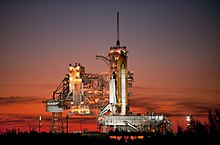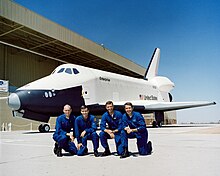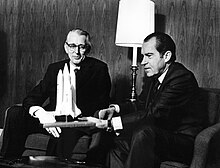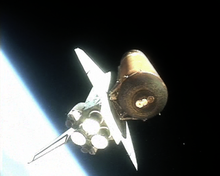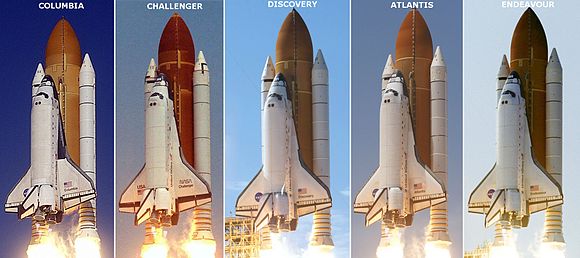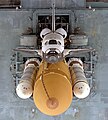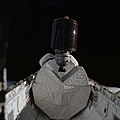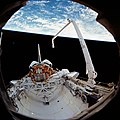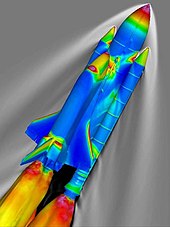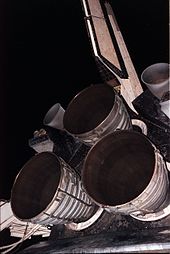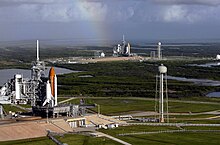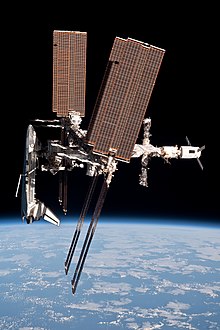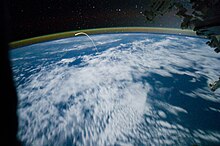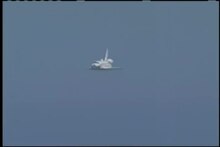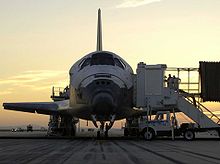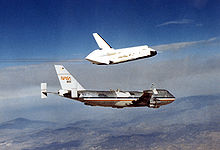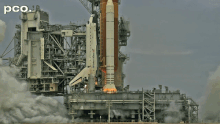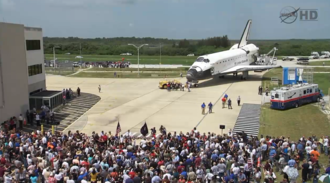
| |
| Function | Crewed orbital launch and reentry |
|---|---|
| Manufacturer | United Space Alliance Thiokol/Alliant Techsystems (SRBs) Lockheed Martin/Martin Marietta (ET) Boeing/Rockwell (orbiter) |
| Country of origin | United States |
| Project cost | US$ 210 billion (2010) |
| Cost per launch | US$ 450 million (2011) to 1.5 billion (2011) |
| Size | |
| Height | 56.1 m (184.2 ft) |
| Diameter | 8.7 m (28.5 ft) |
| Mass | 2,030 t (4,470,000 lb) |
| Stages | 2 |
| Capacity | |
| Payload to LEO | 27,500 kg (60,600 lb) |
| Payload to ISS | 16,050 kg (35,380 lb) |
| Payload to GTO | 3,810 kg (8,400 lb) |
| Payload to Polar orbit | 12,700 kg (28,000 lb) |
| Payload to Earth return | 14,400 kg (31,700 lb) |
| Launch history | |
| Status | Retired |
| Launch sites | LC-39, Kennedy Space Center SLC-6, Vandenberg AFB (unused) |
| Total launches | 135 |
| Successes | 134 launches and 133 landings |
| Failures | 2 Challenger (launch failure, 7 fatalities), Columbia (re-entry failure, 7 fatalities) |
| First flight | April 12, 1981 |
| Last flight | July 21, 2011 |
| Notable payloads | Tracking and Data Relay Satellites Spacelab Hubble Space Telescope Galileo, Magellan, Ulysses Compton Gamma Ray Observatory Mir Docking Module Chandra X-ray Observatory ISS components |
| Boosters - Solid Rocket Boosters | |
| No. boosters | 2 |
| Engines | 2 solid |
| Thrust | 12,500 kN (2,800,000 lbf) each, sea level liftoff |
| Specific impulse | 269 seconds (2.64 km/s) |
| Burn time | 124 s |
| Fuel | Solid (Ammonium perchlorate composite propellant) |
| First stage - Orbiter plus External Tank | |
| Engines | 3 SSMEs located on Orbiter |
| Thrust | 5,250 kN (1,180,000 lbf) total, sea level liftoff |
| Specific impulse | 455 seconds (4.46 km/s) |
| Burn time | 480 s |
| Fuel | LOX/LH2 |
The Space Shuttle was a partially reusable low Earth orbital spacecraft system operated by the U.S. National Aeronautics and Space Administration (NASA) as part of the Space Shuttle program. Its official program name was Space Transportation System (STS), taken from a 1969 plan for a system of reusable spacecraft of which it was the only item funded for development. The first of four orbital test flights occurred in 1981, leading to operational flights beginning in 1982. In addition to the prototype whose completion was cancelled, five complete Shuttle systems were built and used on a total of 135 missions from 1981 to 2011, launched from the Kennedy Space Center (KSC) in Florida. Operational missions launched numerous satellites, interplanetary probes, and the Hubble Space Telescope (HST); conducted science experiments in orbit; and participated in construction and servicing of the International Space Station. The Shuttle fleet's total mission time was 1322 days, 19 hours, 21 minutes and 23 seconds.
Shuttle components included the Orbiter Vehicle (OV) with three clustered Rocketdyne RS-25 main engines, a pair of recoverable solid rocket boosters (SRBs), and the expendable external tank (ET) containing liquid hydrogen and liquid oxygen. The Space Shuttle was launched vertically, like a conventional rocket, with the two SRBs operating in parallel with the OV's three main engines, which were fueled from the ET. The SRBs were jettisoned before the vehicle reached orbit, and the ET was jettisoned just before orbit insertion, which used the orbiter's two Orbital Maneuvering System (OMS) engines. At the conclusion of the mission, the orbiter fired its OMS to de-orbit and re-enter the atmosphere. The orbiter then glided as a spaceplane to a runway landing, usually to the Shuttle Landing Facility at Kennedy Space Center, Florida or Rogers Dry Lake in Edwards Air Force Base, California. After landing at Edwards, the orbiter was flown back to the KSC on the Shuttle Carrier Aircraft, a specially modified Boeing 747.
The first orbiter, Enterprise, was built in 1976, used in Approach and Landing Tests and had no orbital capability. Four fully operational orbiters were initially built: Columbia, Challenger, Discovery, and Atlantis. Of these, two were lost in mission accidents: Challenger in 1986 and Columbia in 2003, with a total of fourteen astronauts killed. A fifth operational (and sixth in total) orbiter, Endeavour, was built in 1991 to replace Challenger. The Space Shuttle was retired from service upon the conclusion of Atlantis's final flight on July 21, 2011. The U.S. has since relied primarily on the Russian Soyuz spacecraft to transport astronauts to the International Space Station.
Overview
The Space Shuttle was a partially reusable human spaceflight vehicle capable of reaching low Earth orbit, commissioned and operated by the U.S. National Aeronautics and Space Administration
(NASA) from 1981 to 2011. It resulted from shuttle design studies
conducted by NASA and the U.S. Air Force in the 1960s and was first
proposed for development as part of an ambitious second-generation Space Transportation System (STS) of space vehicles to follow the Apollo program in a September 1969 report of a Space Task Group headed by Vice President Spiro Agnew to President Richard Nixon.
Nixon's post-Apollo NASA budgeting withdrew support of all system
components except the Shuttle, to which NASA applied the STS name.
The vehicle consisted of a spaceplane for orbit and re-entry, fueled from an expendable External Tank containing liquid hydrogen and liquid oxygen, with two reusable strap-on solid rocket boosters. The first of four orbital test flights occurred in 1981, leading to operational flights beginning in 1982, all launched from the Kennedy Space Center, Florida. The system was retired from service in 2011 after 135 missions, with Atlantis making the final launch of the three-decade Shuttle program on July 8, 2011. The program ended after Atlantis
landed at the Kennedy Space Center on July 21, 2011. Major missions
included launching numerous satellites and interplanetary probes, conducting space science experiments, and servicing and construction of space stations. The first orbiter vehicle, named Enterprise, was used in the initial Approach and Landing Tests phase but installation of engines, heat shielding, and other equipment necessary for orbital flight was cancelled. A total of five operational orbiters were built, and of these, two were destroyed in accidents.
It was used for orbital space missions by NASA, the U.S. Department of Defense, the European Space Agency, Japan, and Germany. The United States funded Shuttle development and operations except for the Spacelab modules used on D1 and D2—sponsored by Germany. SL-J was partially funded by Japan.
STS-129 ready for launch
Shuttle approach and landing test crews, 1976
Early concept for a space shuttle refueling a space tug, 1970
At launch, it consisted of the "stack", including the dark orange external tank (ET) (for the first two launches the tank was painted white); two white, slender solid rocket boosters (SRBs); and the Orbiter Vehicle, which contained the crew
and payload. Some payloads were launched into higher orbits with either
of two different upper stages developed for the STS (single-stage Payload Assist Module or two-stage Inertial Upper Stage). The Space Shuttle was stacked in the Vehicle Assembly Building, and the stack mounted on a mobile launch platform held down by four frangible nuts on each SRB, which were detonated at launch.
The Shuttle stack launched vertically like a conventional rocket. It lifted off under the power of its two SRBs and three main engines,
which were fueled by liquid hydrogen and liquid oxygen from the ET. The
Space Shuttle had a two-stage ascent. The SRBs provided additional
thrust during liftoff and first-stage flight. About two minutes after
liftoff, frangible nuts were fired, releasing the SRBs, which then
parachuted into the ocean, to be retrieved by NASA recovery ships
for refurbishment and reuse. The orbiter and ET continued to ascend on
an increasingly horizontal flight path under power from its main
engines. Upon reaching 17,500 mph (7.8 km/s), necessary for low Earth
orbit, the main engines were shut down. The ET, attached by two
frangible nuts was then jettisoned to burn up in the atmosphere. After jettisoning the external tank, the orbital maneuvering system (OMS) engines were used to adjust the orbit.
The orbiter carried astronauts and payloads such as satellites or space station parts into low Earth orbit, the Earth's upper atmosphere or thermosphere.
Usually, five to seven crew members rode in the orbiter. Two crew
members, the commander and pilot, were sufficient for a minimal flight,
as in the first four "test" flights, STS-1 through STS-4. The typical
payload capacity was about 50,045 pounds (22,700 kg) but could be
increased depending on the choice of launch configuration. The orbiter
carried its payload in a large cargo bay with doors that opened along
the length of its top, a feature which made the Space Shuttle unique
among spacecraft. This feature made possible the deployment of large
satellites such as the Hubble Space Telescope and also the capture and return of large payloads back to Earth.
When the orbiter's space mission was complete, it fired its OMS
thrusters to drop out of orbit and re-enter the lower atmosphere. During descent, the orbiter passed through different layers of the atmosphere and decelerated from hypersonic speed primarily by aerobraking. In the lower atmosphere and landing phase, it was more like a glider but with reaction control system (RCS) thrusters and fly-by-wire-controlled
hydraulically actuated flight surfaces controlling its descent. It
landed on a long runway as a conventional aircraft. The aerodynamic
shape was a compromise between the demands of radically different speeds
and air pressures during re-entry, hypersonic flight, and subsonic
atmospheric flight. As a result, the orbiter had a relatively high sink rate
at low altitudes, and it transitioned during re-entry from using RCS
thrusters at very high altitudes to flight surfaces in the lower
atmosphere.
Early history
President Nixon (right) with NASA Administrator Fletcher in January 1972, three months before Congress approved funding for the Shuttle program
Vision for a Spacelab mission with various equipment in the Shuttle bay
Vision for Space Station Freedom, with an STS orbiter docked
The formal design of what became the Space Shuttle began with the
"Phase A" contract design studies issued in the late 1960s.
Conceptualization had begun two decades earlier, before the Apollo program of the 1960s. One of the places the concept of a spacecraft returning from space to a horizontal landing originated was within NACA, in 1954, in the form of an aeronautics research experiment later named the X-15. The NACA proposal was submitted by Walter Dornberger.
In 1958, the X-15 concept further developed into a proposal to launch an X-15 into space, and another X-series spaceplane proposal, named X-20 Dyna-Soar, as well as variety of aerospace plane concepts and studies. Neil Armstrong
was selected to pilot both the X-15 and the X-20. Though the X-20 was
not built, another spaceplane similar to the X-20 was built several
years later and delivered to NASA in January 1966 called the HL-10 ("HL" indicated "horizontal landing").
In the mid-1960s, the U.S. Air Force conducted classified studies
on next-generation space transportation systems and concluded that
semi-reusable designs were the cheapest choice. It proposed a
development program with an immediate start on a "Class I" vehicle with
expendable boosters, followed by slower development of a "Class II"
semi-reusable design and possible "Class III" fully reusable design
later. In 1967, George Mueller
held a one-day symposium at NASA headquarters to study the options.
Eighty people attended and presented a wide variety of designs,
including earlier U.S. Air Force designs such as the X-20 Dyna-Soar.
In 1968, NASA officially began work on what was then known as the
Integrated Launch and Re-entry Vehicle (ILRV). At the same time, NASA
held a separate Space Shuttle Main Engine (SSME) competition. NASA
offices in Houston and Huntsville jointly issued a Request for Proposal
(RFP) for ILRV studies to design a spacecraft that could deliver a
payload to orbit but also re-enter the atmosphere and fly back to Earth.
For example, one of the responses was for a two-stage design, featuring
a large booster and a small orbiter, called the DC-3,
one of several Phase A Shuttle designs. After the aforementioned "Phase
A" studies, B, C, and D phases progressively evaluated in-depth designs
up to 1972. In the final design, the bottom stage consisted of
recoverable solid rocket boosters, and the top stage used an expendable
external tank.
In 1969, President Richard Nixon decided to support proceeding
with Space Shuttle development. A series of development programs and
analysis refined the basic design, prior to full development and
testing. In August 1973, the X-24B proved that an unpowered spaceplane could re-enter Earth's atmosphere for a horizontal landing.
Across the Atlantic, European ministers met in Belgium in 1973 to
authorize Western Europe's manned orbital project and its main
contribution to Space Shuttle—the Spacelab program. Spacelab would provide a multidisciplinary orbital space laboratory and additional space equipment for the Shuttle.
Description
STS-1 on the launch pad, December 1980
The Space Shuttle was the first operational orbital spacecraft designed for reuse. It carried different payloads to low Earth orbit, provided crew rotation and supplies for the International Space Station
(ISS), and performed satellite servicing and repair. The orbiter could
also recover satellites and other payloads from orbit and return them to
Earth. Each Shuttle was designed for a projected lifespan of 100
launches or ten years of operational life, although this was later
extended. The person in charge of designing the STS was Maxime Faget, who had also overseen the Mercury, Gemini, and Apollo
spacecraft designs. The crucial factor in the size and shape of the
Shuttle orbiter was the requirement that it be able to accommodate the
largest planned commercial and military satellites, and have over 1,000
mile cross-range recovery range to meet the requirement for classified
USAF missions for a once-around abort from a launch to a polar orbit.
The militarily specified 1,085 nmi (2,009 km; 1,249 mi) cross range
requirement was one of the primary reasons for the Shuttle's large
wings, compared to modern commercial designs with very minimal control
surfaces and glide capability. Factors involved in opting for solid
rockets and an expendable fuel tank included the desire of the Pentagon
to obtain a high-capacity payload vehicle for satellite deployment, and
the desire of the Nixon administration to reduce the costs of space exploration by developing a spacecraft with reusable components.
Each Space Shuttle was a reusable launch system composed of three main assemblies: the reusable OV, the expendable ET, and the two reusable SRBs.
Only the OV entered orbit shortly after the tank and boosters are
jettisoned. The vehicle was launched vertically like a conventional
rocket, and the orbiter glided to a horizontal landing like an airplane,
after which it was refurbished for reuse. The SRBs parachuted to
splashdown in the ocean where they were towed back to shore and
refurbished for later Shuttle missions.
Discovery rockets into orbit, seen here just after solid rocket booster (SRB) separation
Tail-end of an orbiter showing various nozzles during an orbital maneuver with ISS
Five operational OVs were built: Columbia (OV-102), Challenger (OV-099), Discovery (OV-103), Atlantis (OV-104), and Endeavour (OV-105). A mock-up, Inspiration, currently stands at the entrance to the Astronaut Hall of Fame. An additional craft, Enterprise
(OV-101), was built for atmospheric testing gliding and landing; it was
originally intended to be outfitted for orbital operations after the
test program, but it was found more economical to upgrade the structural
test article STA-099 into orbiter Challenger (OV-099). An additional test article, dubbed Pathfinder (OV-098), was built for form and fit tests, and is on display at the Alabama Space and Rocket Center in Huntsville, AL. Challenger disintegrated 73 seconds after launch in 1986, and Endeavour was built as a replacement from structural spare components. Building Endeavour cost about US$1.7 billion. Columbia broke apart over Texas during re-entry in 2003.
A Space Shuttle launch cost around $450 million. Roger A. Pielke, Jr. has estimated that the Space Shuttle program cost about US$170 billion (2008 dollars) through early 2008; the average cost per flight was about US$1.5 billion. Two missions were paid for by Germany, Spacelab D1 and D2 (D for Deutschland) with a payload control center in Oberpfaffenhofen. D1 was the first time that control of a manned STS mission payload was not in U.S. hands.
At times, the orbiter itself was referred to as the Space Shuttle. This was not technically correct as the Space Shuttle
was the combination of the orbiter, the external tank, and the two
solid rocket boosters. These components, once assembled in the Vehicle Assembly Building originally built to assemble the Apollo Saturn V rocket, were commonly referred to as the "stack".
Responsibility for the Shuttle components was spread among
multiple NASA field centers. The Kennedy Space Center was responsible
for launch, landing and turnaround operations for equatorial orbits (the
only orbit profile actually used in the program), the U.S. Air Force at
the Vandenberg Air Force Base was responsible for launch, landing and turnaround operations for polar orbits (though this was never used), the Johnson Space Center served as the central point for all Shuttle operations, the Marshall Space Flight Center was responsible for the main engines, external tank, and solid rocket boosters, the John C. Stennis Space Center handled main engine testing, and the Goddard Space Flight Center managed the global tracking network.
Orbiter vehicle
Shuttle launch profiles. From left to right: Columbia, Challenger, Discovery, Atlantis, and Endeavour.
The orbiter resembled a conventional aircraft, with double-delta wings
swept 81° at the inner leading edge and 45° at the outer leading edge.
Its vertical stabilizer's leading edge was swept back at a 50° angle.
The four elevons, mounted at the trailing edge of the wings, and the rudder/speed
brake, attached at the trailing edge of the stabilizer, with the body
flap, controlled the orbiter during descent and landing.
The orbiter's 60-foot (18 m)-long payload bay, comprising most of the fuselage,
could accommodate cylindrical payloads up to 15 feet (4.6 m) in
diameter. Information declassified in 2011 showed that these
measurements were chosen specifically to accommodate the KH-9 HEXAGON spy satellite operated by the National Reconnaissance Office.
Two mostly-symmetrical lengthwise payload bay doors hinged on either
side of the bay comprised its entire top. Payloads were generally loaded
horizontally into the bay while the orbiter was standing upright on the
launch pad and unloaded vertically in the near-weightless orbital
environment by the orbiter's robotic remote manipulator arm
(under astronaut control), EVA astronauts, or under the payloads' own
power (as for satellites attached to a rocket "upper stage" for
deployment.)
Three Space Shuttle Main Engines (SSMEs) were mounted on the
orbiter's aft fuselage in a triangular pattern. The engine nozzles could
gimbal
10.5 degrees up and down, and 8.5 degrees from side to side during
ascent to change the direction of their thrust to steer the Shuttle. The
orbiter structure was made primarily from aluminum alloy, although the engine structure was made primarily from titanium alloy.
The operational orbiters built were OV-102 Columbia, OV-099 Challenger, OV-103 Discovery, OV-104 Atlantis, and OV-105 Endeavour.
- Space Shuttle Atlantis transported by a Boeing 747 Shuttle Carrier Aircraft (SCA), 1998 (NASA)
- An overhead view of Atlantis as it sits atop the Mobile Launcher Platform (MLP) before STS-79. Two Tail Service Masts (TSMs) to either side of the orbiter's tail provide umbilical connections for propellant loading and electrical power.
- Water is released onto the mobile launcher platform on Launch Pad 39A at the start of a sound suppression system test in 2004. During launch, 350,000 US gallons (1,300,000 L) of water are poured onto the pad in 41 seconds.
External tank
An external tank floats away from the orbiter.
Interior of an External Tank
The main function of the Space Shuttle external tank was to supply
the liquid oxygen and hydrogen fuel to the main engines. It was also the
backbone of the launch vehicle, providing attachment points for the two
solid rocket boosters and the orbiter. The external tank was the only
part of the Shuttle system that was not reused. Although the external
tanks were always discarded, it would have been possible to take them
into orbit and re-use them (such as a wet workshop for incorporation into a space station).
Solid rocket boosters
Two solid rocket boosters (SRBs) each provided 12,500 kN (2,800,000 lbf) of thrust at liftoff,
which was 83% of the total thrust at liftoff. The SRBs were jettisoned
two minutes after launch at a height of about 46 km (150,000 ft), and
then deployed parachutes and landed in the ocean to be recovered. The SRB cases were made of steel about ½ inch (13 mm) thick. The solid rocket boosters were re-used many times; the casing used in Ares I engine testing in 2009 consisted of motor cases that had been flown, collectively, on 48 Shuttle missions, including STS-1.
Astronauts who have flown on multiple spacecraft report that Shuttle delivers a rougher ride than Apollo or Soyuz.
The additional vibration is caused by the solid rocket boosters, as
solid fuel does not burn as evenly as liquid fuel. The vibration
dampens down after the solid rocket boosters have been jettisoned.
Orbiter add-ons
The
orbiter could be used in conjunction with a variety of add-ons
depending on the mission. This included orbital laboratories (Spacelab, Spacehab), boosters for launching payloads farther into space (Inertial Upper Stage, Payload Assist Module), and other functions, such as provided by Extended Duration Orbiter, Multi-Purpose Logistics Modules, or Canadarm (RMS). An upper stage called Transfer Orbit Stage (Orbital Science Corp. TOS-21) was also used once with the orbiter.
Other types of systems and racks were part of the modular Spacelab
system —pallets, igloo, IPS, etc., which also supported special missions
such as SRTM.
Spacelab
European astronauts prepare for their Spacelab mission, 1984
Interior of Spacelab LM2
A major component of the Space Shuttle Program was Spacelab,
primarily contributed by a consortium of European countries, and
operated in conjunction with the United States and international
partners.
Supported by a modular system of pressurized modules, pallets, and
systems, Spacelab missions executed on multidisciplinary science,
orbital logistics, and international cooperation. Over 29 missions flew on subjects ranging from astronomy, microgravity, radar, and life sciences, to name a few. Spacelab hardware also supported missions such as Hubble (HST) servicing and space station resupply. STS-2 and STS-3 provided testing, and the first full mission was Spacelab-1 (STS-9) launched on November 28, 1983.
Spacelab formally began in 1973, after a meeting in Brussels, Belgium, by European heads of state.
Within the decade, Spacelab went into orbit and provided Europe and the
United States with an orbital workshop and hardware system. International cooperation, science, and exploration were realized on Spacelab.
Flight systems
The Shuttle was one of the earliest craft to use a computerized fly-by-wire digital flight control system.
This means no mechanical or hydraulic linkages connected the pilot's
control stick to the control surfaces or reaction control system
thrusters. The control algorithm, which used a classical Proportional Integral Derivative (PID) approach, was developed and maintained by Honeywell. The Shuttle's fly-by-wire digital flight control system was composed of 4 control systems each addressing a different mission phase: Ascent, Descent, On-Orbit and Aborts.[citation needed]
Honeywell is also credited with the design and implementation of the
Shuttle's Nose Wheel Steering Control Algorithm that allowed the Orbiter
to safely land at Kennedy Space Center's Shuttle Runway.
A concern with using digital fly-by-wire systems on the Shuttle
was reliability. Considerable research went into the Shuttle computer
system. The Shuttle used five identical redundant IBM 32-bit general
purpose computers (GPCs), model AP-101, constituting a type of embedded system.
Four computers ran specialized software called the Primary Avionics
Software System (PASS). A fifth backup computer ran separate software
called the Backup Flight System (BFS). Collectively they were called the
Data Processing System (DPS).
Simulation
of SSLV at Mach 2.46 and 66,000 ft (20,000 m). The surface of the
vehicle is colored by the pressure coefficient, and the gray contours
represent the density of the surrounding air, as calculated using the OVERFLOW software package.
The design goal of the Shuttle's DPS was fail-operational/fail-safe
reliability. After a single failure, the Shuttle could still continue
the mission. After two failures, it could still land safely.
The four general-purpose computers operated essentially in
lockstep, checking each other. If one computer provided a different
result than the other three (i.e. the one computer failed), the three
functioning computers "voted" it out of the system. This isolated it
from vehicle control. If a second computer of the three remaining
failed, the two functioning computers voted it out. A very unlikely
failure mode would have been where two of the computers produced result
A, and two produced result B (a two-two split). In this unlikely case,
one group of two was to be picked at random.
The Backup Flight System (BFS) was separately developed software
running on the fifth computer, used only if the entire four-computer
primary system failed. The BFS was created because although the four
primary computers were hardware redundant, they all ran the same
software, so a generic software problem could crash all of them.
Embedded system avionic
software was developed under totally different conditions from public
commercial software: the number of code lines was tiny compared to a
public commercial software product, changes were only made infrequently
and with extensive testing, and many programming and test personnel
worked on the small amount of computer code. However, in theory it could
have still failed, and the BFS existed for that contingency. While the
BFS could run in parallel with PASS, the BFS never engaged to take over
control from PASS during any Shuttle mission.
The software for the Shuttle computers was written in a high-level language called HAL/S, somewhat similar to PL/I. It is specifically designed for a real time embedded system environment.
The IBM AP-101 computers originally had about 424 kilobytes of magnetic core memory
each. The CPU could process about 400,000 instructions per second. They
had no hard disk drive, and loaded software from magnetic tape
cartridges.
In 1990, the original computers were replaced with an upgraded
model AP-101S, which had about 2.5 times the memory capacity (about 1
megabyte) and three times the processor speed (about 1.2 million
instructions per second). The memory was changed from magnetic core to
semiconductor with battery backup.
Early Shuttle missions, starting in November 1983, took along the Grid Compass,
arguably one of the first laptop computers. The GRiD was given the name
SPOC, for Shuttle Portable Onboard Computer. Use on the Shuttle
required both hardware and software modifications which were
incorporated into later versions of the commercial product. It was used
to monitor and display the Shuttle's ground position, path of the next
two orbits, show where the Shuttle had line of sight communications with
ground stations, and determine points for location-specific
observations of the Earth. The Compass sold poorly, as it cost at least
US$8000, but it offered unmatched performance for its weight and size. NASA was one of its main customers.
During its service life, the Shuttle's Control System never
experienced a failure. Many of the lessons learned have been used to
design today's high speed control algorithms.
Orbiter markings and insignia
Payload specialist Millie Hughes-Fulford, who flew aboard Columbia in 1991, displays the modernist Blackburn & Danne NASA logotype, known as "the worm".
The prototype orbiter Enterprise originally had a flag of the United States
on the upper surface of the left wing and the letters "USA" in black on
the right wing. The name "Enterprise" was painted in black on the
payload bay doors just above the hinge and behind the crew module; on
the aft end of the payload bay doors was the NASA "worm" logotype
in gray. Underneath the rear of the payload bay doors on the side of
the fuselage just above the wing is the text "United States" in black
with a flag of the United States ahead of it.
The first operational orbiter, Columbia, originally had the same markings as Enterprise, although the letters "USA" on the right wing were slightly larger and spaced farther apart. Columbia also had black markings which Enterprise
lacked on its forward RCS module, around the cockpit windows, and on
its vertical stabilizer, and had distinctive black "chines" on the
forward part of its upper wing surfaces, which none of the other
orbiters had.
Challenger established a modified marking scheme for the shuttle fleet that was matched by Discovery, Atlantis and Endeavour.
The letters "USA" in black above an American flag were displayed on the
left wing, with the NASA "worm" logotype in gray centered above the
name of the orbiter in black on the right wing. The name of the orbiter
was inscribed not on the payload bay doors, but on the forward fuselage
just below and behind the cockpit windows. This would make the name
visible when the shuttle was photographed in orbit with the doors open.
In 1983, Enterprise had its wing markings changed to match Challenger,
and the NASA "worm" logotype on the aft end of the payload bay doors
was changed from gray to black. Some black markings were added to the
nose, cockpit windows and vertical tail to more closely resemble the
flight vehicles, but the name "Enterprise" remained on the payload bay
doors as there was never any need to open them. Columbia had its name moved to the forward fuselage to match the other flight vehicles after STS-61-C, during the 1986–88 hiatus when the shuttle fleet was grounded following the loss of Challenger, but retained its original wing markings until its last overhaul (after STS-93), and its unique black wing "chines" for the remainder of its operational life.
Beginning in 1998, the flight vehicles' markings were modified to incorporate the NASA "meatball" insignia.
The "worm" logotype, which the agency had phased out, was removed from
the payload bay doors and the "meatball" insignia was added aft of the
"United States" text on the lower aft fuselage. The "meatball" insignia
was also displayed on the left wing, with the American flag above the
orbiter's name, left-justified rather than centered, on the right wing.
The three surviving flight vehicles, Discovery, Atlantis and Endeavour, still bear these markings as museum displays. Enterprise became the property of the Smithsonian Institution
in 1985 and was no longer under NASA's control when these changes were
made, hence the prototype orbiter still has its 1983 markings and still
has its name on the payload bay doors.
Upgrades
Atlantis was the first Shuttle to fly with a glass cockpit, on STS-101. (composite image)
The Space Shuttle was initially developed in the 1970s,
but received many upgrades and modifications afterward to improve
performance, reliability and safety. Internally, the Shuttle remained
largely similar to the original design, with the exception of the
improved avionics computers. In addition to the computer upgrades, the
original analog primary flight instruments were replaced with modern
full-color, flat-panel display screens, called a glass cockpit,
which is similar to those of contemporary airliners. To facilitate
construction of ISS, the internal airlocks of each orbiter except Columbia
were replaced with external docking systems to allow for a greater
amount of cargo to be stored on the Shuttle's mid-deck during station
resupply missions.
The Space Shuttle Main Engines (SSMEs) had several improvements
to enhance reliability and power. This explains phrases such as "Main
engines throttling up to 104 percent." This did not mean the engines
were being run over a safe limit. The 100 percent figure was the
original specified power level. During the lengthy development program, Rocketdyne
determined the engine was capable of safe reliable operation at 104
percent of the originally specified thrust. NASA could have rescaled the
output number, saying in essence 104 percent is now 100 percent. To
clarify this would have required revising much previous documentation
and software, so the 104 percent number was retained. SSME upgrades were
denoted as "block numbers", such as block I, block II, and block IIA.
The upgrades improved engine reliability, maintainability and
performance. The 109% thrust level was finally reached in flight
hardware with the Block II engines in 2001. The normal maximum throttle
was 104 percent, with 106 percent or 109 percent used for mission
aborts.
For the first two missions, STS-1 and STS-2,
the external tank was painted white to protect the insulation that
covers much of the tank, but improvements and testing showed that it was
not required. The weight saved by not painting the tank resulted in an
increase in payload capability to orbit.
Additional weight was saved by removing some of the internal
"stringers" in the hydrogen tank that proved unnecessary. The resulting
"light-weight external tank" was first flown on STS-6 and used on the majority of Shuttle missions. STS-91
saw the first flight of the "super light-weight external tank". This
version of the tank was made of the 2195 aluminum-lithium alloy. It
weighed 3.4 metric tons (7,500 lb) less than the last run of lightweight
tanks, allowing the Shuttle to deliver heavy elements to ISS's high
inclination orbit. As the Shuttle was always operated with a crew, each of these improvements was first flown on operational mission flights.
The solid rocket boosters underwent improvements as well. Design engineers added a third O-ring seal to the joints between the segments after the 1986 Space Shuttle Challenger disaster.
The three nozzles of the Space Shuttle Main Engine with the two Orbital Maneuvering System (OMS) pods, and the vertical stabilizer above.
Several other SRB improvements were planned to improve performance
and safety, but never came to be. These culminated in the considerably
simpler, lower cost, probably safer and better-performing Advanced Solid Rocket Booster.
These rockets entered production in the early to mid-1990s to support
the Space Station, but were later canceled to save money after the
expenditure of $2.2 billion.
The loss of the ASRB program resulted in the development of the Super
LightWeight external Tank (SLWT), which provided some of the increased
payload capability, while not providing any of the safety improvements.
In addition, the U.S. Air Force developed their own much lighter
single-piece SRB design using a filament-wound system, but this too was
canceled.
STS-70 was delayed in 1995, when woodpeckers bored holes in the foam insulation of Discovery's
external tank. Since then, NASA has installed commercial plastic owl
decoys and inflatable owl balloons which had to be removed prior to
launch. The delicate nature of the foam insulation had been the cause of damage to the Thermal Protection System,
the tile heat shield and heat wrap of the orbiter. NASA remained
confident that this damage, while it was the primary cause of the Space
Shuttle Columbia disaster on February 1, 2003, would not
jeopardize the completion of the International Space Station (ISS) in
the projected time allotted.
A cargo-only, unmanned variant of the Shuttle was variously proposed and rejected since the 1980s. It was called the Shuttle-C,
and would have traded re-usability for cargo capability, with large
potential savings from reusing technology developed for the Space
Shuttle. Another proposal was to convert the payload bay into a
passenger area, with versions ranging from 30 to 74 seats, three days in
orbit, and cost US$1.5 million per seat.
On the first four Shuttle missions, astronauts wore modified U.S.
Air Force high-altitude full-pressure suits, which included a
full-pressure helmet during ascent and descent. From the fifth flight, STS-5, until the loss of Challenger, one-piece light blue nomex
flight suits and partial-pressure helmets were worn. A less-bulky,
partial-pressure version of the high-altitude pressure suits with a
helmet was reinstated when Shuttle flights resumed in 1988. The
Launch-Entry Suit ended its service life in late 1995, and was replaced
by the full-pressure Advanced Crew Escape Suit (ACES), which resembled the Gemini space suit in design, but retained the orange color of the Launch-Entry Suit.
To extend the duration that orbiters could stay docked at the ISS, the Station-to-Shuttle Power Transfer System
(SSPTS) was installed. The SSPTS allowed these orbiters to use power
provided by the ISS to preserve their consumables. The SSPTS was first
used successfully on STS-118.
Specifications
Space Shuttle orbiter illustration
Space Shuttle drawing
Space Shuttle wing cutaway
Space Shuttle Orbiter and Soyuz-TM (drawn to scale).
Atlantis and Endeavour
on launch pads. This particular occasion is due to the final Hubble
servicing mission, where the International Space Station is unreachable,
which necessitates having a Shuttle on standby for a possible rescue
mission.
Orbiter (for Endeavour, OV-105)
- Length: 122.17 ft (37.237 m)
- Wingspan: 78.06 ft (23.79 m)
- Height: 56.58 ft (17.25 m)
- Empty weight: 172,000 lb (78,000 kg)
- Gross liftoff weight (Orbiter only): 240,000 lb (110,000 kg)
- Maximum landing weight: 230,000 lb (100,000 kg)
- Payload to Landing (Return Payload): 32,000 lb (14,400 kg)
- Maximum payload: 55,250 lb (25,060 kg)
- Payload to LEO (204 kilometers (110 nmi) @ 28.5° inclination: 27,500 kilograms (60,600 lb)
- Payload to LEO (407 kilometers (220 nmi) @ 51.6° to ISS): 16,050 kilograms (35,380 lb)
- Payload to GTO: 8,390 lb (3,806 kg)
- Payload to Polar Orbit: 28,000 lb (12,700 kg)
- Note launch payloads modified by External Tank (ET) choice (ET, LWT, or SLWT)
- Payload bay dimensions: 15 by 59 ft (4.6 by 18 m) (diameter by length)
- Operational altitude: 100 to 520 nmi (190 to 960 km; 120 to 600 mi)
- Speed: 7,743 m/s (27,870 km/h; 17,320 mph)
- Crossrange: 1,085 nmi (2,009 km; 1,249 mi)
- Main Stage (SSME with external tank)
- Engines: Three Rocketdyne Block II SSMEs, each with a sea level thrust of 393,800 lbf (1,752 kN) at 104% power
- Thrust (at liftoff, sea level, 104% power, all 3 engines): 1,181,400 lbf (5,255 kN)
- Specific impulse: 455 seconds (4.46 km/s)
- Burn time: 480 s
- Fuel: Liquid Hydrogen/Liquid Oxygen
- Orbital Maneuvering System
- Engines: 2 OMS Engines
- Thrust: 53.4 kN (12,000 lbf) combined total vacuum thrust
- Specific impulse: 316 seconds (3.10 km/s)
- Burn time: 150–250 s typical burn; 1250 s deorbit burn
- Fuel: MMH/N2O4
- Crew: Varies.
-
- The earliest Shuttle flights had the minimum crew of two; many later missions a crew of five. By program end, typically seven people would fly: (commander, pilot, several mission specialists, one of whom (MS-2) acted as the flight engineer starting with STS-9 in 1983). On two occasions, eight astronauts have flown (STS-61-A, STS-71). Eleven people could be accommodated in an emergency mission.
External tank (for SLWT)
- Length: 46.9 m (153.8 ft)
- Diameter: 8.4 m (27.6 ft)
- Propellant volume: 2,025 m3 (534,900 U.S. gal)
- Empty weight: 26,535 kg (58,500 lb)
- Gross liftoff weight (for tank): 756,000 kg (1,670,000 lb)
Solid Rocket Boosters
- Length: 45.46 m (149 ft)
- Diameter: 3.71 m (12.2 ft)
- Empty weight (each): 68,000 kg (150,000 lb)
- Gross liftoff weight (each): 571,000 kg (1,260,000 lb)
- Thrust (at liftoff, sea level, each): 12,500 kN (2,800,000 lbf)
- Specific impulse: 269 seconds (2.64 km/s)
- Burn time: 124 s
System Stack
- Height: 56 m (180 ft)
- Gross liftoff weight: 2,000,000 kg (4,400,000 lb)
- Total liftoff thrust: 30,160 kN (6,780,000 lbf)
Mission profile
STS mission profile
Shuttle launch of Atlantis at sunset in 2001. The Sun is behind the camera, and the plume's shadow intersects the Moon across the sky.
Launch preparation
All Space Shuttle missions were launched from Kennedy Space Center (KSC). The weather criteria used for launch included, but were not limited to: precipitation, temperatures, cloud cover, lightning forecast, wind, and humidity. The Shuttle was not launched under conditions where it could have been struck by lightning.
Aircraft are often struck by lightning with no adverse effects because
the electricity of the strike is dissipated through its conductive
structure and the aircraft is not electrically grounded.
Like most jet airliners, the Shuttle was mainly constructed of
conductive aluminum, which would normally shield and protect the
internal systems. However, upon liftoff the Shuttle sent out a long
exhaust plume as it ascended, and this plume could have triggered
lightning by providing a current path to ground. The NASA Anvil Rule for
a Shuttle launch stated that an anvil cloud could not appear within a distance of 10 nautical miles.
The Shuttle Launch Weather Officer monitored conditions until the final
decision to scrub a launch was announced. In addition, the weather
conditions had to be acceptable at one of the Transatlantic Abort
Landing sites (one of several Space Shuttle abort modes) to launch as well as the solid rocket booster recovery area. While the Shuttle might have safely endured a lightning strike, a similar strike caused problems on Apollo 12, so for safety NASA chose not to launch the Shuttle if lightning was possible (NPR8715.5).
Historically, the Shuttle was not launched if its flight would
run from December to January (a year-end rollover or YERO). Its flight
software, designed in the 1970s, was not designed for this, and would
require the orbiter's computers be reset through a change of year, which
could cause a glitch while in orbit. In 2007, NASA engineers devised a
solution so Shuttle flights could cross the year-end boundary.
Launch
After the
final hold in the countdown at T-minus 9 minutes, the Shuttle went
through its final preparations for launch, and the countdown was
automatically controlled by the Ground Launch Sequencer (GLS), software
at the Launch Control Center, which stopped the count if it sensed a
critical problem with any of the Shuttle's onboard systems. The GLS
handed off the count to the Shuttle's on-board computers at T minus 31
seconds, in a process called auto sequence start.
At T-minus 16 seconds, the massive sound suppression system (SPS) began to drench the Mobile Launcher Platform (MLP) and SRB trenches with 300,000 US gallons (1,100 m3) of water to protect the Orbiter from damage by acoustical energy and rocket exhaust reflected from the flame trench and MLP during lift off.
At T-minus 10 seconds, hydrogen igniters were activated under
each engine bell to quell the stagnant gas inside the cones before
ignition. Failure to burn these gases could trip the onboard sensors and
create the possibility of an overpressure and explosion of the vehicle
during the firing phase. The main engine turbopumps also began charging
the combustion chambers with liquid hydrogen and liquid oxygen at this
time. The computers reciprocated this action by allowing the redundant
computer systems to begin the firing phase.
Space Shuttle Main Engine ignition
The three main engines (SSMEs) started at T-6.6 seconds. The
main engines ignited sequentially via the Shuttle's general purpose
computers (GPCs) at 120 millisecond intervals. All three SSMEs were
required to reach 90% rated thrust within three seconds, otherwise the
onboard computers would initiate an RSLS abort. If all three engines indicated nominal performance by T-3
seconds, they were commanded to gimbal to liftoff configuration and the
command would be issued to arm the SRBs for ignition at T-0. Between T-6.6 seconds and T-3
seconds, while the SSMEs were firing but the SRBs were still bolted to
the pad, the offset thrust caused the entire launch stack (boosters,
tank and orbiter) to pitch down 650 mm (25.5 in) measured at the tip of
the external tank. The three second delay after confirmation of SSME
operation was to allow the stack to return to nearly vertical. At T-0 seconds, the 8 frangible nuts holding the SRBs to the pad were detonated, the SSMEs were commanded to 100% throttle, and the SRBs were ignited. By T+0.23 seconds, the SRBs built up enough thrust for liftoff to commence, and reached maximum chamber pressure by T+0.6 seconds. The Johnson Space Center's Mission Control Center assumed control of the flight once the SRBs had cleared the launch tower.
Shortly after liftoff, the Shuttle's main engines were throttled
up to 104.5% and the vehicle began a combined roll, pitch and yaw
maneuver that placed it onto the correct heading (azimuth) for the
planned orbital inclination and in a heads down attitude with wings
level. The Shuttle flew upside down during the ascent phase. This
orientation allowed a trim angle of attack that was favorable for
aerodynamic loads during the region of high dynamic pressure, resulting
in a net positive load factor, as well as providing the flight crew with
a view of the horizon as a visual reference. The vehicle climbed in a
progressively flattening arc, accelerating as the mass of the SRBs and
main tank decreased. To achieve low orbit requires much more horizontal
than vertical acceleration. This was not visually obvious, since the
vehicle rose vertically and was out of sight for most of the horizontal
acceleration. The near circular orbital velocity at the 380 kilometers
(236 mi) altitude of the International Space Station is 27,650 km/h
(17,180 mph), roughly equivalent to Mach 23 at sea level. As the
International Space Station orbits at an inclination of 51.6 degrees,
missions going there must set orbital inclination to the same value in
order to rendezvous with the station.
Around 30 seconds into ascent, the SSMEs were throttled
down—usually to 72%, though this varied—to reduce the maximum
aerodynamic forces acting on the Shuttle at a point called Max Q.
Additionally, the propellant grain design of the SRBs caused their
thrust to drop by about 30% by 50 seconds into ascent. Once the
Orbiter's guidance verified that Max Q would be within Shuttle
structural limits, the main engines were throttled back up to 104.5%;
this throttling down and back up was called the "thrust bucket". To
maximize performance, the throttle level and timing of the thrust bucket
was shaped to bring the Shuttle as close to aerodynamic limits as
possible.
Solid Rocket Booster (SRB) separation during STS-1. The white external tank pictured was used on STS-1 and STS-2.
At around T+126 seconds, pyrotechnic fasteners
released the SRBs and small separation rockets pushed them laterally
away from the vehicle. The SRBs parachuted back to the ocean to be
reused. The Shuttle then began accelerating to orbit on the main
engines. Acceleration at this point would typically fall to .9 g,
and the vehicle would take on a somewhat nose-up angle to the horizon –
it used the main engines to gain and then maintain altitude while it
accelerated horizontally towards orbit. At about five and three-quarter
minutes into ascent, the orbiter's direct communication links with the
ground began to fade, at which point it rolled heads up to reroute its
communication links to the Tracking and Data Relay Satellite system.
At about seven and a half minutes into ascent, the mass of the
vehicle was low enough that the engines had to be throttled back to
limit vehicle acceleration to 3 g (29.4 m/s² or 96.5 ft/s²,
equivalent to accelerating from zero to 105.9 km/h (65.8 mph) in a
second). The Shuttle would maintain this acceleration for the next
minute, and main engine cut-off (MECO) occurred at about eight and a
half minutes after launch.
The main engines were shut down before complete depletion of
propellant, as running dry would have destroyed the engines. The oxygen
supply was terminated before the hydrogen supply, as the SSMEs reacted
unfavorably to other shutdown modes. (Liquid oxygen has a tendency to
react violently, and supports combustion when it encounters hot engine
metal.) A few seconds after MECO, the external tank was released by
firing pyrotechnic fasteners.
At this point the Shuttle and external tank were on a slightly suborbital trajectory, coasting up towards apogee. Once at apogee, about half an hour after MECO, the Shuttle's Orbital Maneuvering System (OMS) engines were fired to raise its perigee
and achieve orbit, while the external tank fell back into the
atmosphere and burned up over the Indian Ocean or the Pacific Ocean
depending on launch profile.
The sealing action of the tank plumbing and lack of pressure relief
systems on the external tank helped it break up in the lower atmosphere.
After the foam burned away during re-entry, the heat caused a pressure
buildup in the remaining liquid oxygen and hydrogen until the tank
exploded. This ensured that any pieces that fell back to Earth were
small.
- Ascent tracking
Contraves-Goerz Kineto Tracking Mount used to image the space Shuttle during launch ascent
The Shuttle was monitored throughout its ascent for short range
tracking (10 seconds before liftoff through 57 seconds after), medium
range (7 seconds before liftoff through 110 seconds after) and long
range (7 seconds before liftoff through 165 seconds after). Short range
cameras included 22 16mm cameras on the Mobile Launch Platform and 8
16mm on the Fixed Service Structure, 4 high speed fixed cameras located
on the perimeter of the launch complex plus an additional 42 fixed
cameras with 16mm motion picture film. Medium range cameras included
remotely operated tracking cameras at the launch complex plus 6 sites
along the immediate coast north and south of the launch pad, each with
800mm lens and high speed cameras running 100 frames per second. These
cameras ran for only 4–10 seconds due to limitations in the amount of
film available. Long range cameras included those mounted on the
external tank, SRBs and orbiter itself which streamed live video back to
the ground providing valuable information about any debris falling
during ascent. Long range tracking cameras with 400-inch film and
200-inch video lenses were operated by a photographer at Playalinda Beach as well as 9 other sites from 38 miles north at the Ponce Inlet to 23 miles south to Patrick Air Force Base
(PAFB) and additional mobile optical tracking camera was stationed on
Merritt Island during launches. A total of 10 HD cameras were used both
for ascent information for engineers and broadcast feeds to networks
such as NASA TV and HDNet. The number of cameras significantly increased and numerous existing cameras were upgraded at the recommendation of the Columbia Accident Investigation Board to provide better information about the debris during launch. Debris was also tracked using a pair of Weibel Continuous Pulse Doppler X-band radars, one on board the SRB recovery ship MV Liberty Star
positioned north east of the launch pad and on a ship positioned south
of the launch pad. Additionally, during the first 2 flights following
the loss of Columbia and her crew, a pair of NASA WB-57
reconnaissance aircraft equipped with HD Video and Infrared flew at
60,000 feet (18,000 m) to provide additional views of the launch ascent.
Kennedy Space Center also invested nearly $3 million in improvements
to the digital video analysis systems in support of debris tracking.
In orbit
Once in orbit, the Shuttle usually flew at an altitude of 320 km (170 nmi), although the STS-82 mission reached 620 km (330 nmi).
In the 1980s and 1990s, many flights involved space science missions on
the NASA/ESA Spacelab, or launching various types of satellites and
science probes. By the 1990s and 2000s the focus shifted more to
servicing the space station, with fewer satellite launches. Most
missions involved staying in orbit several days to two weeks, although
longer missions were possible with the Extended Duration Orbiter add-on or when attached to a space station. STS-80 was the longest at almost 17 days and 16 hours.
Atlantis docked at Harmony module of the International Space Station
Astronaut with satellite
Endeavour docked at ISS
Re-entry and landing
Almost the entire Space Shuttle re-entry procedure, except for
lowering the landing gear and deploying the air data probes, was
normally performed under computer control. However, the re-entry could
be flown entirely manually if an emergency arose. The approach and
landing phase could be controlled by the autopilot, but was usually hand
flown.
Glowing plasma trail from Space Shuttle Atlantis re-entry as seen from the Space Station
The vehicle began re-entry by firing the Orbital maneuvering system
engines, while flying upside down, backside first, in the opposite
direction to orbital motion for approximately three minutes, which
reduced the Shuttle's velocity by about 200 mph (322 km/h). The
resultant slowing of the Shuttle lowered its orbital perigee
down into the upper atmosphere. The Shuttle then flipped over, by
pushing its nose down (which was actually "up" relative to the Earth,
because it was flying upside down). This OMS firing was done roughly
halfway around the globe from the landing site.
The vehicle started encountering more significant air density in the lower thermosphere at about 400,000 ft (120 km), at around Mach 25, 8,200 m/s (30,000 km/h; 18,000 mph). The vehicle was controlled by a combination of RCS thrusters
and control surfaces, to fly at a 40-degree nose-up attitude, producing
high drag, not only to slow it down to landing speed, but also to
reduce reentry heating. As the vehicle encountered progressively denser
air, it began a gradual transition from spacecraft to aircraft. In a
straight line, its 40-degree nose-up attitude would cause the descent
angle to flatten-out, or even rise. The vehicle therefore performed a
series of four steep S-shaped banking turns, each lasting several
minutes, at up to 70 degrees of bank, while still maintaining the
40-degree angle of attack. In this way it dissipated speed sideways
rather than upwards. This occurred during the 'hottest' phase of
re-entry, when the heat-shield glowed red and the G-forces were at their
highest. By the end of the last turn, the transition to aircraft was
almost complete. The vehicle leveled its wings, lowered its nose into a
shallow dive and began its approach to the landing site.
- A Space Shuttle model undergoes a wind tunnel test in 1975. This test is simulating the ionized gasses that surround a Shuttle as it reenters the atmosphere.
The orbiter's maximum glide ratio/lift-to-drag ratio varies considerably with speed, ranging from 1:1 at hypersonic speeds, 2:1 at supersonic speeds and reaching 4.5:1 at subsonic speeds during approach and landing.
In the lower atmosphere, the orbiter flies much like a
conventional glider, except for a much higher descent rate, over 50 m/s
(180 km/h; 110 mph) or 9,800 fpm. At approximately Mach 3, two air data
probes, located on the left and right sides of the orbiter's forward
lower fuselage, are deployed to sense air pressure related to the
vehicle's movement in the atmosphere.
- Final approach and landing phase
STS-127, Space Shuttle Endeavour landing video, 2009
When the approach and landing phase began, the orbiter was at a
3,000 m (9,800 ft) altitude, 12 km (7.5 mi) from the runway. The pilots
applied aerodynamic braking to help slow down the vehicle. The orbiter's
speed was reduced from 682 to 346 km/h (424 to 215 mph), approximately,
at touch-down (compared to 260 km/h or 160 mph for a jet airliner). The
landing gear was deployed while the Orbiter was flying at 430 km/h
(270 mph). To assist the speed brakes, a 12 m (39 ft) drag chute was
deployed either after main gear or nose gear touchdown (depending on
selected chute deploy mode) at about 343 km/h (213 mph). The chute was
jettisoned once the orbiter slowed to 110 km/h (68.4 mph).
- Endeavour brake chute deploys after touching down
Post-landing processing
Discovery after landing on Earth for crew disembarkment
After landing, the vehicle stayed on the runway for several hours for
the orbiter to cool. Teams at the front and rear of the orbiter tested
for presence of hydrogen, hydrazine, monomethylhydrazine, nitrogen tetroxide and ammonia (fuels and by-products of the reaction control system and the orbiter's three APUs).
If hydrogen was detected, an emergency would be declared, the orbiter
powered down and teams would evacuate the area. A convoy of 25 specially
designed vehicles and 150 trained engineers and technicians approached
the orbiter. Purge and vent lines were attached to remove toxic gases
from fuel lines and the cargo bay about 45–60 minutes after landing. A flight surgeon
boarded the orbiter for initial medical checks of the crew before
disembarking. Once the crew left the orbiter, responsibility for the
vehicle was handed from the Johnson Space Center back to the Kennedy
Space Center.
If the mission ended at Edwards Air Force Base in California, White Sands Space Harbor in New Mexico, or any of the runways the orbiter might use in an emergency, the orbiter was loaded atop the Shuttle Carrier Aircraft, a modified 747, for transport back to the Kennedy Space Center, landing at the Shuttle Landing Facility.
Once at the Shuttle Landing Facility, the orbiter was then towed 2
miles (3.2 km) along a tow-way and access roads normally used by tour
buses and KSC employees to the Orbiter Processing Facility where it began a months-long preparation process for the next mission.
Landing sites
Atlantis deploys the landing gear before landing.
NASA preferred Space Shuttle landings to be at Kennedy Space Center.
If weather conditions made landing there unfavorable, the Shuttle
could delay its landing until conditions are favorable, touch down at
Edwards Air Force Base, California, or use one of the multiple alternate
landing sites around the world. A landing at any site other than
Kennedy Space Center meant that after touchdown the Shuttle must be
mated to the Shuttle Carrier Aircraft and returned to Cape Canaveral. Space Shuttle Columbia (STS-3) once landed at the White Sands Space Harbor, New Mexico; this was viewed as a last resort as NASA scientists believed that the sand could potentially damage the Shuttle's exterior.
There were many alternative landing sites that were never used.
Risk contributors
Discovery at ISS in 2011 (STS-133)
An example of technical risk analysis for a STS mission is SPRA iteration 3.1 top risk contributors for STS-133:
- Micro-Meteoroid Orbital Debris (MMOD) strikes
- Space Shuttle Main Engine (SSME)-induced or SSME catastrophic failure
- Ascent debris strikes to TPS leading to LOCV on orbit or entry
- Crew error during entry
- RSRM-induced RSRM catastrophic failure (RSRM are the rocket motors of the SRBs)
- COPV failure (COPV are tanks inside the orbiter that hold gas at high pressure)
An internal NASA risk assessment study (conducted by the Shuttle Program Safety and Mission Assurance Office at Johnson Space Center)
released in late 2010 or early 2011 concluded that the agency had
seriously underestimated the level of risk involved in operating the
Shuttle. The report assessed that there was a 1 in 9 chance of a
catastrophic disaster during the first nine flights of the Shuttle but
that safety improvements had later improved the risk ratio to 1 in 90.
Fleet history
Flight timeline

Major events
OV-101 Enterprise takes flight for the first time over Dryden Flight Research Facility, Edwards, California in 1977 as part of the Shuttle program's Approach and Landing Tests (ALT).
Atlantis lifts off from Launch Pad 39A at NASA's Kennedy Space Center in Florida on the STS-132 mission to the International Space Station at 2:20 pm EDT on May 14, 2010. This was one of the last scheduled flights for Atlantis before it was retired.
STS-135 last Space Shuttle liftoff in slow motion
Below is a list of major events in the Space Shuttle orbiter fleet:
| Date | Orbiter | Major event / remarks |
|---|---|---|
| September 17, 1976 | Enterprise | Prototype Space Shuttle Enterprise was rolled out of its assembly facility in Southern California and displayed before a crowd of several thousand people. |
| February 18, 1977 | Enterprise | First flight; Attached to Shuttle Carrier Aircraft throughout flight. |
| August 12, 1977 | Enterprise | First free flight; Tailcone on; lakebed landing. |
| October 26, 1977 | Enterprise | Final Enterprise free flight; First landing on Edwards AFB concrete runway. |
| April 12, 1981 | Columbia | First Columbia flight, first orbital test flight; STS-1 |
| November 11, 1982 | Columbia | First operational flight of the Space Shuttle, first mission to carry four astronauts; STS-5 |
| April 4, 1983 | Challenger | First Challenger flight; STS-6 |
| August 30, 1984 | Discovery | First Discovery flight; STS-41-D |
| October 3, 1985 | Atlantis | First Atlantis flight; STS-51-J |
| October 30, 1985 | Challenger | First and only crew of eight astronauts; STS-61-A |
| January 28, 1986 | Challenger | Loss of vehicle 73 seconds after launch; STS-51-L; all seven crew members died. |
| September 29, 1988 | Discovery | First post-Challenger mission; STS-26 |
| May 4, 1989 | Atlantis | The first Space Shuttle mission to launch an interplanetary probe, Magellan; STS-30 |
| April 24, 1990 | Discovery | Launch of the Hubble Space Telescope; STS-31 |
| May 7, 1992 | Endeavour | First Endeavour flight; STS-49 |
| November 19, 1996 | Columbia | Longest Shuttle mission at 17 days, 15 hours; STS-80 |
| December 4, 1998 | Endeavour | First ISS mission; STS-88 |
| February 1, 2003 | Columbia | Disintegrated during re-entry; STS-107; all seven crew members died. |
| July 25, 2005 | Discovery | First post-Columbia mission; STS-114 |
| February 24, 2011 | Discovery | Last Discovery flight; STS-133 |
| May 16, 2011 | Endeavour | Last Endeavour mission; STS-134 |
| July 8, 2011 | Atlantis | Last Atlantis flight and last Space Shuttle flight; STS-135 |
Sources: NASA launch manifest, NASA Space Shuttle archive
Disasters
STS-51-L crew: (front row) Michael J. Smith, Dick Scobee, Ronald McNair; (back row) Ellison Onizuka, Christa McAuliffe, Gregory Jarvis, Judith Resnik
On January 28, 1986, Challenger disintegrated 73 seconds after
launch due to the failure of the right SRB, killing all seven
astronauts on board. The disaster was caused by low-temperature
impairment of an O-ring, a mission critical seal used between segments
of the SRB casing. Failure of the O-ring allowed hot combustion gases
to escape from between the booster sections and burn through the
adjacent external tank, causing it to explode.
Repeated warnings from design engineers voicing concerns about the lack
of evidence of the O-rings' safety when the temperature was below 53 °F
(12 °C) had been ignored by NASA managers.
On February 1, 2003, Columbia disintegrated during re-entry, killing its crew of seven, because of damage to the carbon-carbon
leading edge of the wing caused during launch. Ground control engineers
had made three separate requests for high-resolution images taken by
the Department of Defense that would have provided an understanding of
the extent of the damage, while NASA's chief thermal protection system (TPS) engineer requested that astronauts on board Columbia
be allowed to leave the vehicle to inspect the damage. NASA managers
intervened to stop the Department of Defense's assistance and refused
the request for the spacewalk, and thus the feasibility of scenarios for astronaut repair or rescue by Atlantis were not considered by NASA management at the time.
Retirement
Atlantis orbiter's final welcome home, 2011
NASA retired the Space Shuttle in 2011, after 30 years of service.
The Shuttle was originally conceived of and presented to the public as a
"Space Truck", which would, among other things, be used to build a
United States space station in low earth orbit
in the early 1990s. When the U.S. space station evolved into the
International Space Station project, which suffered from long delays and
design changes before it could be completed, the retirement of the
Space Shuttle was delayed several times until 2011, serving at least 15
years longer than originally planned. Discovery was the first of NASA's three remaining operational Space Shuttles to be retired.
The final Space Shuttle mission was originally scheduled for late
2010, but the program was later extended to July 2011 when Michael
Suffredini of the ISS program said that one additional trip was needed
in 2011 to deliver parts to the International Space Station.
The Shuttle's final mission consisted of just four
astronauts—Christopher Ferguson (Commander), Douglas Hurley (Pilot),
Sandra Magnus (Mission Specialist 1), and Rex Walheim (Mission
Specialist 2); they conducted the 135th and last space Shuttle mission on board Atlantis, which launched on July 8, 2011, and landed safely at the Kennedy Space Center on July 21, 2011, at 5:57 AM EDT (09:57 UTC).
Distribution of orbiters and other hardware
Space Shuttle Program commemorative patch
NASA announced it would transfer orbiters to education institutions
or museums at the conclusion of the Space Shuttle program. Each museum
or institution is responsible for covering the US$28.8 million
cost of preparing and transporting each vehicle for display. Twenty
museums from across the country submitted proposals for receiving one of
the retired orbiters. NASA also made Space Shuttle thermal protection system tiles available to schools and universities for less than US$25 each. About 7,000 tiles were available on a first-come, first-served basis, limited to one per institution.
Orbiters on display
On April 12, 2011, NASA announced selection of locations for the remaining Shuttle orbiters:
- Atlantis is on display at the Kennedy Space Center Visitor Complex, near Cape Canaveral, Florida. It was delivered to the Visitor Complex on November 2, 2012.
- Discovery was delivered to the Udvar-Hazy Center of the Smithsonian Institution's National Air and Space Museum in Chantilly, Virginia, near Washington, D.C. on April 19, 2012. On April 17, 2012, Discovery was flown atop a 747 Shuttle Carrier Aircraft escorted by a NASA T-38 Talon chase aircraft in a final farewell flight. The 747 and Discovery flew over Washington, D.C. and the metropolitan area around 10 am and arrived at Dulles around 11 am. The flyover and landing were widely covered on national news media.
Endeavour at Los Angeles International Airport
- Endeavour was delivered to the California Science Center in Los Angeles, California on October 14, 2012. It arrived at Los Angeles International Airport on September 21, 2012 escorted by two NASA F/A-18 Hornet chase aircraft, concluding a two-day, cross country journey atop the Shuttle Carrier Aircraft after stops at Ellington Field in Houston, Biggs Army Airfield in El Paso and the Dryden Flight Research Facility at Edwards Air Force Base, California.
- Enterprise (atmospheric test orbiter) was on display at the National Air and Space Museum's Udvar-Hazy Center but was moved to New York City's Intrepid Sea-Air-Space Museum in mid-2012.
In August 2011, the NASA Office of Inspector General
(OIG) published a "Review of NASA's Selection of Display Locations for
the Space Shuttle Orbiters"; the review had four main findings:
- "NASA's decisions regarding Orbiter placement were the result of an Agency-created process that emphasized above all other considerations locating the Orbiters in places where the most people would have the opportunity to view them";
- "the Team made several errors during its evaluation process, including one that would have resulted in a numerical 'tie' among the Intrepid, the Kennedy Visitor Complex, and the National Museum of the U.S. Air Force (Air Force Museum) in Dayton, Ohio";
- there is "no evidence that the Team's recommendation or the Administrator's decision were tainted by political influence or any other improper consideration";
- "some of the choices NASA made during the selection process – specifically, its decision to manage aspects of the selection as if it were a competitive procurement and to delay announcement of its placement decisions until April 2011 (more than 2 years after it first solicited information from interested entities)—may intensify challenges to the Agency and the selectees as they work to complete the process of placing the Orbiters in their new homes."
The NASA OIG had three recommendations, saying NASA should:
- "expeditiously review recipients' financial, logistical, and curatorial display plans to ensure they are feasible and consistent with the Agency's educational goals and processing and delivery schedules";
- "ensure that recipient payments are closely coordinated with processing schedules, do not impede NASA's ability to efficiently prepare the Orbiters for museum display, and provide sufficient funds in advance of the work to be performed; and"
- "work closely with the recipient organizations to minimize the possibility of delays in the delivery schedule that could increase the Agency's costs or impact other NASA missions and priorities."
In September 2011, the CEO and two board members of Seattle's Museum of Flight met with NASA Administrator Charles Bolden,
pointing out "significant errors in deciding where to put its four
retiring Space Shuttles"; the errors alleged include inaccurate
information on Museum of Flight's attendance and international visitor
statistics, as well as the readiness of the Intrepid Sea-Air-Space Museum's exhibit site.
Orbiter replicas on display
- Independence, formerly known as Explorer, is a full-scale, high-fidelity replica of the Space Shuttle. It was built by Guard-Lee in Apopka, Florida, installed at Kennedy Space Center Visitor Complex in 1993, and moved to Space Center Houston in 2012. It was built using schematics, blueprints and archival documents provided by NASA and by shuttle contractors such as Rockwell International. While many of the features on the replica are simulated, some parts, including the landing gear's Michelin tires, have been used in the Space Shuttle program.[110] The model is on display, mounted on top of the original Shuttle Carrier Aircraft (NASA 905) outside of the Visitors' Center.
- Pathfinder (honorary Orbiter Vehicle Designation: OV-098) is a Space Shuttle test simulator made of steel and wood. Constructed by NASA in 1977 as an unnamed test article, it was purchased in the early 1980s by the America-Japan Society, Inc. which had it refurbished, named it, and placed it on display in the Great Space Shuttle Exhibition in Tokyo. The mockup was later returned to the United States and placed on permanent display at the U.S. Space & Rocket Center in Huntsville, Alabama, in May 1988.
Hardware on display
Flight and mid-deck training hardware will be taken from the Johnson Space Center and will go to the National Air and Space Museum and the National Museum of the U.S. Air Force. The full fuselage mockup, which includes the payload bay and aft section but no wings, is to go to the Museum of Flight in Seattle. Mission Simulation and Training Facility's fixed simulator will go to the Adler Planetarium in Chicago, and the motion simulator will go to the Texas A&M Aerospace Engineering Department in College Station, Texas. Other simulators used in Shuttle astronaut training will go to the Wings of Dreams Aviation Museum in Starke, Florida and the Virginia Air and Space Center in Hampton, Virginia.
Successors and legacy
STS conducted numerous experiments in space, such as this ionization experiment
Sprint cameras, tested by the Shuttle, may be used on ISS and other missions
Until another U.S. manned spacecraft is ready, crews will travel to and from the International Space Station (ISS) exclusively aboard the Russian Soyuz spacecraft.
A planned successor to STS was the "Shuttle II", during the 1980s
and 1990s, and later the Constellation program during the 2004–2010
period. CSTS was a proposal to continue to operate STS commercially,
after NASA. In September 2011, NASA announced the selection of the design for the new Space Launch System that is planned to launch the Orion spacecraft and other hardware to missions beyond low earth-orbit.
The Commercial Orbital Transportation Services program began in 2006 with the purpose of creating commercially operated unmanned cargo vehicles to service the ISS. The Commercial Crew Development
(CCDev) program was started in 2010 to create commercially operated
manned spacecraft capable of delivering at least four crew members to
the ISS, to stay docked for 180 days, and then return them back to
Earth. These spacecraft were to become operational in the 2010s.
In popular culture
Space
Shuttles have been features of fiction and nonfiction, from children's
movies to documentaries. Early examples include the 1979 James Bond film, Moonraker, the 1982 Activision videogame Space Shuttle: A Journey into Space (1982) and G. Harry Stine's 1981 novel Shuttle Down. In the 1986 film SpaceCamp, Atlantis accidentally launches into space with a group of U.S. Space Camp participants as its crew. A space shuttle named Intrepid is featured in the 1989 film Moontrap.
The 1998 film Armageddon
portrays a combined crew of offshore oil rig workers and U.S. military
staff who pilot two modified Shuttles to avert the destruction of Earth
by an asteroid. Retired American test pilots visit a Russian satellite
in the 2000 Clint Eastwood adventure film Space Cowboys. In the 2003 film The Core, the Endeavour's
landing is disrupted by the Earth's magnetic core, and its crew is
selected to pilot a vehicle designed to restart the core. The 2004
Bollywood movie Swades,
where a Space Shuttle is used to launch a special rainfall monitoring
satellite, was filmed at Kennedy Space Center in the year after the Columbia disaster that had taken the life of Indian-American astronaut KC Chawla.
On television, the 1996 drama The Cape portrays the lives of a group of NASA astronauts as they prepare for and fly Shuttle missions. Odyssey 5
was a short-lived sci-fi series that features the crew of a Space
Shuttle as the last survivors of a disaster that destroys Earth. The
1997–2007 sci-fi series Stargate SG-1 has a shuttle rescue written into an episode.
The 2013 film Gravity features the fictional Space Shuttle Explorer
during STS-157, whose crew are killed or left stranded after it is
destroyed by a shower of high speed orbital debris. The 2017 Lego film The Lego Batman Movie features a hybrid between the Batmobile and a Space Shuttle, named "the Bat Space Shuttle" by Dick Grayson. It's clearly based on the Lego City set 3367 ("Space Shuttle"), but is black and weapon-equipped.
The Space Shuttle has also been the subject of toys and models; for example, a large Lego Space Shuttle model was constructed by visitors at Kennedy Space Center, and smaller models have been sold commercially as a standard "LegoLand" set. A 1980 pinball machine Space Shuttle was produced by Zaccaria and a 1984 pinball machine Space Shuttle: Pinball Adventure was produced by Williams
and features a plastic Space Shuttle model among other artwork of
astronauts on the play field. The Space Shuttle also appears in a number
of flight simulator and space flight simulator games such as Microsoft Space Simulator, Orbiter, FlightGear, X-Plane and Space Shuttle Mission 2007. Several Transformers toys were modeled after the Space Shuttle.
U.S. postage commemorations
The U.S. Postal Service has released several postage issues that
depict the Space Shuttle. The first such stamps were issued in 1981, and
are on display at the National Postal Museum.
